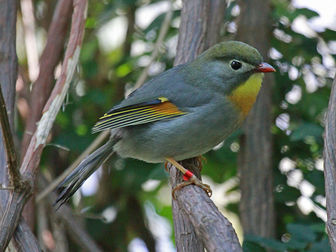Red-billed leiothrix
Adults have bright red bills and a dull yellow ring around their eyes. Their backs are dull olive green, and they have a bright yellow-orange throat with a yellow chin; females are somewhat duller than males, and juveniles have black bills.

Original source: Own work
Author: DickDaniels (http://carolinabirds.org/)
Permission: GNU Free Documentation License
The Red-billed leiothrix is classified as Least Concern. Does not qualify for a more at risk category. Widespread and abundant taxa are included in this category.
Red-billed Leiothrix in the Hawaiian Islands. Known in the cage bird trade as the Japanese Hill-Robin, Peking Robin, or Peking Nightingale, the Red-billed Leiothrix was first imported into the Hawaiian Islands in 1911 (Fisher and Baldwin 1947), with intentional releases to the wild occurring after 1918 (Caum 1933). A native of Southeast Asia, southern China, and the Himalayan regions of India, this species is a medium-sized, green and yellow babbler with a conspicuous red bill and strongly notched tail. More
The Red-billed Leiothrix, Leiothrix lutea, is a member of the Old World babbler family. It is a common cagebird and amongst aviculturists it goes by various names: Pekin Robin, Pekin Nightingale, Chinese Nightingale, Japanese Nightingale, and Japanese (Hill) Robin, the last two being misnomers as it is not native to Japan. Adults have bright red bills and a dull yellow ring around their eyes. More
Red-billed Leiothrix: Forages on the ground and in the lower branches of dense vegetation. Feeds mostly on fruits, including strawberry guava, overripe papaya, and thimbleberry; also eats insects. Vocalization Red-billed Leiothrix: Males sing complex, long songs during breeding season. Year-round uses a shorter, simple song. Warbling and melodious song similar to Red-whiskered Bulbul. Both sexes use unique,short calls to stay together. When feeding utters "pu pu pu pu" or "pe pe pe pa". More
Red-billed Leiothrix: Introduced to Kauai in 1918, to other islands in the 1920s-1930s. May no longer exist on Kauai, populations fluctuate on other islands. Found in native and exotic forests from ocean level to mountain tops. Native to Southeast Asia, Himalayan region of India, and southern China. More
The Red-billed Leiothrix is native to Southern Asia. It has also been introduced on the Hawaiian Islands and small populations of escapees have existed in Japan since the 1980s. Contents * 1 Description * 2 Distribution and habitat * 3 Ecology and behavior * 3.1 Diet * 3. More
Red-billed Leiothrix aka Pekin Robins, Pekin Nightingales, Chinese Nightingales and Japanese (Hill) Robins = Old World Babblers Pekin RobinThe Red-billed Leiothrix Leiothrix lutea is a member of the Old World babbler family. It is a common cagebird and amongst aviculturists it goes by various names: Pekin Robin, Pekin Nightingale, Chinese Nightingale and Japanese (Hill) Robin, the last being a misnomer as it is not native to Japan. More
Red-billed Leiothrix Red-billed Leiothrix (Leiothrix lutea) is a local resident in Himalayas and hills of north-east India. In 1998, the Red-billed Leiothrix was added to Appendix II of CITES (Convention for International Trade in Endangered Species) because its native habitat is being destroyed and the demand for Leiothrix for the cage bird market. Size: 13 cm. Weight: 21-25 gm. Identification: The Red-billed Leiothrix is a babbler beautifully marked with bright coloring. More
Aspects of the topic red-billed leiothrix are discussed in the following places at Britannica. Assorted References * description (in Leiothrix (bird genus)) genus of birds of the babbler family Timaliidae (order Passeriformes), with two species: the silver-eared mesia, or silver-ear (L. argentauris), and the red-billed leiothrix (L. More
The Red-billed Leiothrix is a babbler whose length is about 14cm. They are beautifully marked with bright coloring. The adults have bright red bills and a dull yellow ring around their eyes. Their backs are dull olive green and have a bright yellow-orange throat with a yellow chin. They have forked tails. Female Leiothrix are similar to males but with a duller shade. Juveniles have black bills and gray coats. This Leiothrix is also known for it's vocalizations. It sings loud, melodious songs. More
red-billed leiothrix lives in the underbrush of mountain forests, where it often travels in small flocks singing its melodious song. It feeds mainly on insects and fruit. The leiothrix is also called the pekin robin. Did You Know? - This is such a popular cage bird that the demand in the pet trade is causing its numbers to decline in certain parts of its range. More
In 1998, the Red-billed Leiothrix was added to Appendix II of CITES (Convention for International Trade in Endangered Species) because its native habitat is being destroyed and the demand for Leiothrix for the cage bird market. Even so, their populations still prosper in Hawaii. Populations remain stable in Hawaii except for Kauai where they have recently disappeared. More

Original source: frank wouters from antwerpen, belgium , Belgi
Author: frank wouters from antwerpen, belgium , Belgi
Permission: Some rights reserved
Family : Timaliidae
Genus : Leiothrix
Species : lutea
Authority : (Scopoli, 1786)

